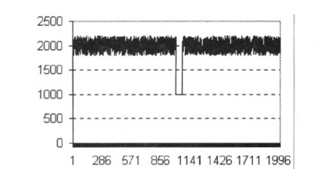题目内容
We know the effect calories have on your body. For each pound of weight that your body carries,it takes about 12 calories per pound per day to keep it alive. If you weigh 150 pounds, you therefore need about 1 , 800 calories per day to keep yourself alive and maintain that same weight.
If you were to eat more than 1 , 800 calories per day,the surplus(剩余) turns into fat. It takes about 3,600 excess(过量的) calories to make a pound of fat.
Let's say that you were to eat,on average, 2,000 calories per day. That extra 200 calories per day is going to turn into fat. However, you will eventually hit a point of equilibrium(平衡, 均衡) because as you gain weight, you need more calories to maintain that weight. So,a person eating an average of 2,000 calories per day will hit equilibrium at (2,000/12) 166. 67 pounds.
So let's say that you eat,on average, 2 , 000 calories per day and reach equilibrium at 166 pounds. Then you go on a crash diet where you eat only 1 , 000 calories per day for 60 days. You lose 16 pounds and reach your target weight of 150 pounds. But then you go right back to eating 2 , 000 calories per day again. The graph below shows your eating pattern before, during and after the diet:

Note that the graph assumes that you,like most people, eat a random(无计划的) number of calories per day. Some days you are "good" and eat less,and some days you are "bad" and eat more,but the assumption is that it averages out to 2, 000 calories per day over the long run.
This graph shows what happens to your weight before ,during and after the diet :

The diet really takes the weight off. But the weight comes right back when you return to your "normal" eating pattern. The weight appears to come back so quickly because when you are at your lightest,you tend to gain more weight each day. The lighter you are,the fewer calo?ries you need. If you only need 1,500 calories per day and you're eating 2,000,you're going to gain weight faster than if you need 1,800 and you're eating 2,000.
There are only two ways to keep the weight off :
Change your overall eating pattern so that you take in,on average,fewer calories than be?fore you go on the diet.
Start exercising so that you "burn" the extra calories you take in.
The best course of action is a combination of these two choices.
( ) 5. The problem that the writer tries to deal with is .
A. how to lose weight fast while changing the diet
B. why the weight comes back so quickly once one stops dieting
C. how to reach the point of equilibrium
D. what your target weight is
( ) 6. What can we learn from the two graphs?
A. It is hard to keep one's normal weight.
B. The better way for you to lose weight is keeping your dieting.
C. You will gain weight faster than before dieting.
D. It is not necessary for you to lose weight by dieting.
( ) 7. According to the passage,if you weighed 100 pounds and you were to eat on average 1400 calories per day,a year later,you would be .
A. 100 pounds
B. 166. 67 pounds
C. 97 pounds
D. 116. 67 pounds
( ) 8. What is the best way to keep the weight off according to the passage?
A. Keep your diet and never stop.
B. Return your overall eating pattern and exercise more.
C. Take in fewer calories than before your diet and exercise more.
D. Go on your diet and start exercising to burn the extra calories.
5-8 BCDC
B篇从科学的角度解释了为什么人们停止节食后体重迅速反弹的原因。
5.B细节理解题。从倒数第四段可知作者进行分析的目的是解释一旦停止节食,反弹就会迅速出现的原因。
6.C逻辑推理题。通过两个图的比较及说明,我们可以知道节食后,因为你的体重减低,所需要的能量小了,而一旦停止节食,摄人量和需求量的差距增大,你储存的热量就增多,那么,转化成脂肪的速度增快,你就增重较快。
7.D数字计算题。100磅的人每天需1200 calories的热量,每天增加200 calories,一年可增体重16. 67磅,所以选D项。
8.C逻辑推理题。从最后一段可推断出1.要停止节食后的摄人量要比节食前少,注意,作者没有要求你一直节食;2.增加运动量,消耗脂肪。
